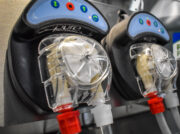
CATEGORY: Scopes

Jul 10, 2024
2024 GI Reprocessing Landscape Report Insights: Key Year-Over-Year Takeaways
The 2024 GI Reprocessing Landscape Report surveyed hundreds of GI reprocessing professionals across the country and yielded interesting insights (if you haven’t read the report, it can be downloaded here). One substantial benefit of annual surveys and reports, however, is the ability to compare insights from the previous year to better understand how trends, challenges, and perceptions are evolving year-over-year. Here are some of the notable changes in our 2024 reports compared to 2023: SPD Crossovers In 2023, 58% of participants signaled having previous experience in sterile processing departments. In 2024, that number rose to over 67%; a notable increase. One potential driving factor of this increase could be the implementation of recommendations made to ANSI/AAMI ST91:2021, leading hospitals to consolidate endoscope reprocessing to sterile processing away from GI, or a shift in job responsibilities. Further, training and education allowing for technicians and nurses to become multi-disciplinary within facilities, filling in for SPD and vice-versa could result in more GI professionals obtaining experience in SPD. How people are entering the industry In 2023, 81.57% of participants indicated that entered the GI department from another healthcare-related field or department. The same held true in 2024, with just over 81% of participants again citing previous healthcare work preceding their time in GI. This should be a signal to managers and others in leadership that one of the best places to look to fill roles is within your own facility. Lateral career changes from departments within the hospital like sterile processing, the OR, facilities maintenance or similar positions may offer new opportunities for people already employed at your facility. Common problems seen in GI reprocessing departments 2023 saw inadequate space (56.25%), lack of training & development opportunities (55.65%), and poor investment in technology and equipment (51.30%) identified as the top three most common problems participants saw in GI reprocessing. In 2024, these problems remained the most common in the eyes of participants, with inadequate space and lack of training and development opportunities being pointed to by over 52% of participants each. Poor investment in technology and equipment, however, dropped to 40.84%. This drop from 51% in 2023 could signal that investment in GI departments has seen an uptick from 2023 to 2024. Alternatively, it could be indicative of a generally higher sense of satisfaction related to the tools and equipment GI professionals have at their disposal. Easy problems to solve 21.37% of participants cited training & education as the top easy problem for departments to tackle in 2023. In 2024, this number grew to 28.24%. This may be the result of stagnant training practices within departments but might also be a sign that GI professionals see ample training & education opportunities to take advantage of, but they aren’t being prioritized or given the time or resources to act on them. GI nurses and technicians are seeing the need for additional training and education as scope complexity increases, and view vendor in-servicing as underutilized by their department. 16.24% considered technology and equipment challenges as being easy to solve in 2023. Equipment and technology was knocked out of the top three easiest challenges to solve by participants in 2024, with 15.88% of participants pointing to processes as the second-easiest problem for GI departments to solve, with equipment and technology falling to 5th with 10% of participants. While this could be viewed as a change in priorities among participants, it could also be a shift in how the problem is perceived. Investment in equipment & technology is often the catalyst for changes and optimization of processes. The rise of processes as an issue to address may indicate that nurses and technicians recognize that equipment and technology, while certainly drivers of process changes, isn’t the only way to improve them. Further, changes in guidelines and IFUs and growing volume may be fueling the need to streamline and overhaul existing processes to be more effective. The most important problems to solve Lack of training and certification was deemed the most important problem to solve by participants in 2023, with 14.52% pointing to it. IFU compliance came behind it at 10.48%. While compliance remains the second most important problem to solve with 19.30% of participants expressing concern over it, training and education dropped to the third most important issue GI should tackle with 18.71% of participants pointing to it. Processes was the most important problem in the eyes of GI professionals in 2024, with 19.88% signaling the need to improve. These results, coupled with the results regarding which problems are perceived as being easy to solve could indicate that GI nurses and technicians see the need to optimize processes within their departments, and see the methods by which to accomplish these optimizations, but don’t see a means of getting the changes implemented. What makes departments great to work in People and teams continue to be what GI professionals find important when assessing what makes a department truly great to be a part of. 55.12% of participants cited people and how teams work together as the top factors associated with great endoscopy departments. 2024 saw that grouping expand to 66.50%, with 34% referencing their teammates and staff directly. Other factors included a shared sense of pride or purpose, a healthy work culture fostered by the team, and having a patient-centric mentality related to their work. Why people are leaving GI/endoscopy departments 39.62% of participants pointed to working conditions, such as stress, ergonomics and burnout as the factor contributing most to departures from GI departments. In 2024, that number grew to 40.11%, demonstrating staying power among participants and continued concerns with working conditions. Lack of upward mobility remained in the second position, but dropped from 21.70% in 2023 to 15.25% in 2024, while lack of appreciation fell from number three in 2023 with 16.04% of participants citing it to just 7.34% indicating lack of appreciation as contributing factor related to turnover. Management style grew from 5.66% in 2023 to a noteworthy 14.12% in…
Read More











